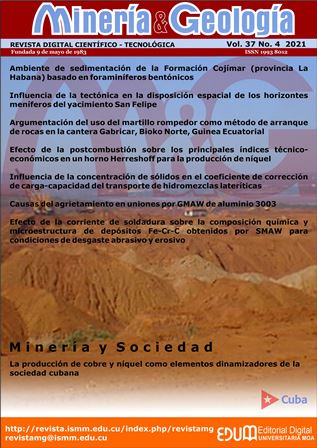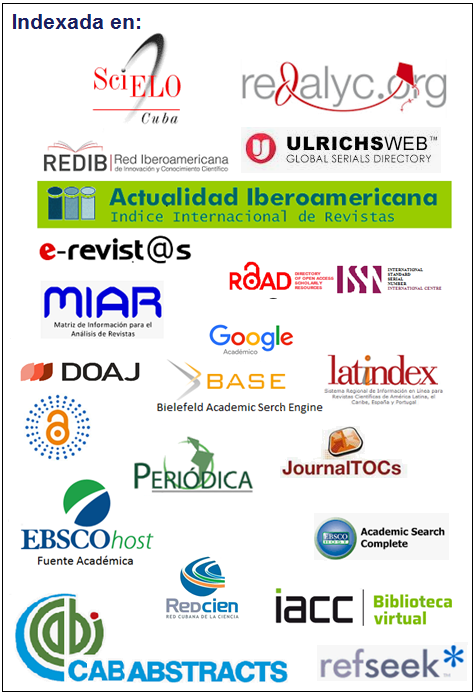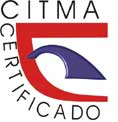Causes of cracking aluminum 3003 joints by GMAW
Keywords:
failure, cracking, aluminum alloys, GMAW welding.Abstract
A frequent problem, whose solution requires a scientific approach due to its phenomenological essence, is cracking in aluminum joints. The causes of cracking in 3003 aluminum joints by GMAW (gas metal arc welding) are defined in this research. The study was carried out on actual joints in a food product container. A refrigerated disk was used for extracting the sample, trying not to alter the material to maintain evidence of possible causes of failure. Macrograph of the welded joints, and visual inspection, chemical analysis by optical emission spectrometry, stress testing of base material analyzes were performed to the joint sample. We conclude that the lack of fusion and penetration is the cause of cracking, which act as stress concentrations and they were originated by deficiencies when carrying out welding.Downloads
References
American Society for Testing and Materials. 2015: Designation: ASTM E-8. Standard Test Methods for Tension Testing of Metallic Materials.
American Society for Testing and Materials. 2015: Designation: ASTM E-340. Standard Test Method for Macroetching Metals and Alloys.
American Society for Testing and Materials. 2014: Designation: ASTM B-209. Standard Specification for Aluminum and Aluminum-Alloy Sheet and Plate.
American Society for Testing and Materials. 2011: Designation: ASTM E3. Standard Guide for Preparation of Metallographic Specimens.
American Welding Society. 2018: AWS A 5.10-18. Specification for Bare Aluminum and Aluminum-Alloy Welding Electrodes and Rods.
Barnes, T.A. & Pashby, I.R. 2008: Joining techniques for aluminium spaceframes used in automobiles. Journal of Materials Processing Technology, 99 (1–3): 72-79.
Bloem, C.A.; Salvador, M. D.; Amigó, V. & Vicente, A. 2001. Comportamiento a fatiga de uniones soldadas mediante MIG de la aleación de aluminio AA 7020. Memorias Jornadas SAM – CONAMET – AAS, Septiembre, 2001.
Huang, C.; Kou, S. 2003: Liquation Cracking in Partial-Penetration Aluminum Welds: Effect of Penetration Oscillation and Backfilling. Welding Journal, 82(7):184s-194s.
International Institute of Welding. 2010: The Physics of Welding. Wheaton and Co. Ltd., Exeter, Great Britain.
Mossman, M. M. & Lippold J. C. 2002: Weldability Testing of Dissimilar Combinations of 5000- and 6000-Series Aluminum Alloys. Welding Journal, 81(9) :188s-194s.
Tan, Y.B.; Wanga, X.M.; Maaj, M.; Zhanga; X.; Liua, W.C.; Fua, R.D.; Xiangb, S. 2017: A study on microstructure and mechanical properties of AA 3003 aluminum alloy joints by underwater friction stir welding. Materials Characterization, 127: 41–52.
Tsai, C. L.; Kim, D. S. & Papritan, D. J. 1991: Analysis of Fatigue Crack Propagation Behavior in Fillet-Welded T-Joints”. Welding Journal Supplement, june: 150s-155s
Published
How to Cite
Issue
Section
- Authors retain copyright and guaranteeing the right magazine to be the first publication of the work as licensed under a Creative Commons Attribution-NonCommercial that allows others to share the work with an acknowledgment of the work's authorship and initial publication in this journal.
- Authors may establish separate supplemental agreements for the exclusive distribution version of the work published in the journal (eg, place it in an institutional repository or publish it in a book), with an acknowledgment of its initial publication in this journal.
- Authors are allowed and recommended to disseminate their work through the Internet (e.g., in institutional telematic archives or on their websites) before and during the submission process, which can produce interesting exchanges and increase citations of the published work. (See The effect of open access)




